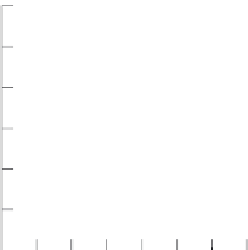Environmental Engineering Reference
In-Depth Information
(a)
(b)
(c)
3
1000
60
2
40
1
20
0
0
0
0
1000
2000
3000
0
1000
2000
3000
0
1000 2000 3000
C addition (g
C
m
-2
)
C addition (g
C
m
-2
)
C addition (g
C
m
-2
)
Fig. 9.12
Relationships between amount of carbon added to the soil the previous year and (a) soil nitrate concentration, (b)
biomass of all weed species combined and (c) biomass of all native prairie plants combined. (After Blumenthal et al., 2003.)
9.7
Sustainable
agroecosystems
9.7
Sustainable
agroecosystems
A trophic cascade, in which top predators reduce herbivore populations and thus
benefi t the plant trophic level, can provide a useful and natural pest control mecha-
nism for certain crops. The tangle web spider,
Nesticodes rufi pes
, is the most abun-
dant of several predatory species found on crops of broccoli (
Brassica oleracea
) in
Hawaii. In addition, two species of bird, the red-crested and northern cardinals
(
Paroaria coronata
and
Cardinalis cardinalis
), have been observed to feed on caterpil-
lars of various butterfl ies and moths, including the cabbage butterfl y (
Artogeia
rapae
), which is the most abundant pest of broccoli crops. Four treatments were
established in a series of experimental broccoli plots: (i) spiders were excluded by
daily hand removal (birds only); (ii) both birds and spiders were present; (iii) birds
were excluded by cages that permitted access to spiders (spiders only); and (iv) birds
were excluded and spiders removed daily.
Access to birds (with or without spiders) led to the biggest reduction in caterpillar
density, minimal defoliation damage (because of reduced herbivore activity) and
large crop weights (Table 9.1). This evidence of a strong trophic cascade provides
good reason for protecting or enhancing bird populations around the crop. On their
own, spiders had a smaller effect, but they did reduce caterpillar density to a degree,
with some benefi t in reducing defoliation and increasing broccoli biomass. Perhaps
their effect should be called a trophic trickle.
9.7.1
Stopping
caterpillars eating the
broccoli - so that
people can
9.7.1
Stopping
caterpillars eating the
broccoli - so that
people can
9.7.2
Managing
agriculture to
minimize fertilizer
input and nutrient
loss
Intensive agriculture is frequently associated with pollution, by phosphorus or
nitrogen, of the waterways that drain the land. This happens when there is a mis-
match between the application of fertilizer (rich in P or N or both) and its use by
the intended recipients - crop plants, forest trees or pasture (and, subsequently,
grazing stock animals). Excess nitrate that fi nds its way into drinking water may
pose a health hazard, potentially contributing to the formation of carcinogenic nit-
rosamines. The US Environmental Protection Agency recommends a maximum
concentration of 10 mg/liter. Moreover, nitrogen and other plant nutrients that leach
into the groundwater, and thence into rivers, lakes, estuaries and oceans, can pro-
foundly affect aquatic food webs and ecosystem functioning. For now, let's consider





























































































Search WWH ::

Custom Search